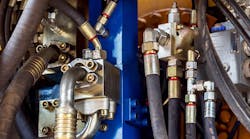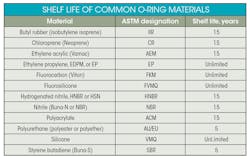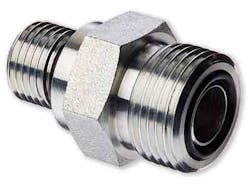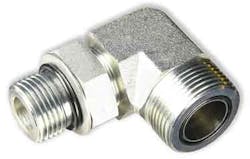Your Connection is Only as Good as its O-ring
Consider a hydraulic fitting with a Buna-N O-ring that has been stored in a parts bin for who knows how long—probably years. As is often the case, it’s no longer sealed in its original plastic bag. Now, what if that storage bin is in an outdoor tool shed in Florida, where the average humidity in July can reach 80%?
Under the proper conditions a Buna-N O-ring has a shelf life of 15 years—again, under proper conditions. One of those conditions is the humidity must be less than 75%. You can pretty much bet the fitting in question has been exposed to frequent humidity. Pull it out of the bin, put it into service, and you may be asking for trouble—leaks, damage to equipment, or worse.
Not all O-rings are created equal. Too often they are just an afterthought, even though they are essential components that the system depends on. A lot rides on each O-ring you purchase and put into service. If even one fails, an entire system may have to be shut down, equipment could be damaged, and even personal injury can result.
The Shelf Life of a Fitting is Only as Long its O-Ring
The shelf life of an O-ring or other elastomeric seal begins with the manufactured date and depends on being properly packaged and stored under specific conditions, even when in the body of a fitting. The shelf life of rubber is not an exact science because it is significantly impacted by storage and handling. A common misconception is that fittings made of metal last forever in the box, provided they are not stored in a corrosive environment. Although that is true, to a point, if an unused fitting has an O-ring, its shelf life is only as long as that of the O-ring.
The rubber industry uses older U.S. military specifications and current SAE aerospace recommendations to calculate O-ring shelf life in quarter-year units. Therefore, the manufacturing cure date can occur anytime within three months, and the shelf life expiration time does not begin until after the first full quarter thereafter. For instance, if an O-ring is cured on January 1, 2019 it would have a cure date established as 1Q19. Aging for determining shelf life expiration would be considered to begin April 1, 2019. Therefore, an O-ring with a three-year shelf life would expire April 1, 2022 and so would the fitting, unless a new O-ring is properly installed in the fitting.
Standards for Shelf Life
The conditions of shelf life for O-rings other elastomeric seals are governed by SAE International Standard ARP5316D. ARP5316D encompasses:
Humidity. Relative humidity ratings assume that fluctuations in ambient temperature do not result in condensation. An O-ring, or fitting with an O-ring, should be sealed in a moisture-proof bag where the ambient relative humidity is less than 75% and less than 65% for polyurethanes.
Light. O-rings and elastomers must be shielded from direct sunlight or ultraviolet.
Ozone. Even during storage, O-rings should be protected from contact with ozone, ozone-generating equipment, and combustible gases and vapors.
Radiation. O-ring elastomers must not be exposed to ionizing radiation.
Temperature. O-rings and fittings with O- must be stored at temperatures below 100°F (38° C), except in cases where higher temperatures are caused by temporary climate changes. They should also be stored away from direct sources of heat, such as direct sunlight, boilers, and radiators.
According to SAE-ARP5316D and general industry standards, common O-ring material shelf life recommendations are:
- 5 years for (millable) polyurethane, SBR, natural rubber, polybutadine, and polyisoprene
- 15 years for Nitrile, Neoprene, HNBR, polyacrylate, and butyl
- Unlimited shelf life for ethylene propylene, fluorocarbon, perfluorinated elastomer silicone, tetrafluoroethylene propylene (Aflas), and fluorosilicone
Materials of Construction
O-rings are available in an extremely wide variety of materials and proprietary formulations to accommodate virtually any application.
Buna-N (Nitrile) is the most common material used in quick-acting couplings. It is solvent, oil and water resistant, and used in applications with temperatures ranging from −40° to 250°F (−40° to 12°C). It is the simplest type of O-ring material and provides excellent sealing properties and durability. Buna-N is commonly used with crude oil, gasoline, propane, petroleum oils, and water.
O-rings made of Buna-N are frequently used in engines, gearboxes, and many other applications, ranging from shower heads and garden hoses to pumps in aircrafts. Buna-N O-Rings are frequently used as face-to-face gaskets or as a shaft seals, and easily allow both rotary and linear movement. These O-Rings often serve as a packing or toric joint, which is simply a mechanical gasket creating a seal at the interface.
Peroxide-cured EPDM (ethylene-propylene-diene rubber) is the standard O-ring material for medical grade polypropylene couplings and resists attack from most chemicals. EPDM is frequently used in medical devices, automotive manufacturing, water and wastewater systems, and other challenging applications.
Fluorocarbon (Viton) O-rings are used in many applications where resistance to extreme temperatures and chemicals is important. They provide outstanding resistance to ozone, oxygen, mineral oil, synthetic hydraulic fluids, fuels, aromatics, and many organic solvents and chemicals. Fluorocarbon O-rings provide excellent permeability, compression-set resistance, and have low gas permeability. They are ideal as gaskets for sealing fuel lines. Other fluorocarbon compounds can also offer improved resistance to acids, fuels, water, and steam.
Silicone O-ring material is ideal in dry heat applications, is odorless and non-toxic. They are safely used in temperatures ranging from −70°F to 400°F (−57°C to 204°C) and are commonly used in medical devices, food storage products, electronics, automotive manufacturing, and even home repair and hardware products.
FFKM (Kalrez) O-rings are highly resistant to chemicals and high temperatures. FFKM perfluoroelastomer O-rings are some of the strongest and most dependable in most industrial applications. They exhibit extremely long service life and are highly resistant to many elements. FFKM is one of the few materials that can withstand extreme temperature, pressure, and provide excellent chemical resistance all in the same application, making it an ideal material in the most demanding of environments.
Forms and Functions
O-rings are used in most fluid power connections, preventing leaks in fittings, valves, pumps, and cylinders of all types. They are used in pneumatic and hydraulic applications, in both static and dynamic systems. O-rings are more than just a rubber seal; many different types of material are used for many types of applications. There are also many considerations when selecting material—most importantly, the combinations of fitting material and the media being transferred. Most O-rings are made of elastomers, yet some are made of metal. Material selection is based on chemical compatibility, application temperature, sealing pressure, durometer (hardness), and size.
This adapter fitting is an example of a male O-ring boss connection. The connection on the back end is a male JIC connection.
The most common O-ring styles, material options, and applications include:
O-ring boss (ORB) connections join two fluid-carrying pipes, hoses, or tubes. In an O-ring boss system, a male-threaded part turns into a female-threaded part to provide a mechanical seal. In an ORB seal, an additional nut is tightened over the O-ring into a chamfered area, creating a fluid-tight seal. The AS568-901 through 932 O-ring sizes are used for sealing straight-thread tube fittings in a boss. O-ring boss systems are most commonly used in hydraulics, compressed air systems, and on vacuum pumps.
Flange connections require front-face static sealing for both internal and external pressure applications. These types of seals are available in a wide range of materials. Flange connections are typically used with tubing applications that have an OD greater than 7/8 in. or for extremely high pressure.
Split flanges typically use an O-ring to seal the joint to contain pressurized fluid. Split-flange assemblies contain four components; a permanent flanged head connected to the tube, an O-ring and two mating clamp halves with four bolts to connect the split-flange. The elastomeric O-ring sits in a groove on a flange and mates with a flat surface on the port. The O-ring flange is attached to the port using the mounting bolts to tighten down the O-ring flange onto the flange clamps.
Flare O-rings are typically made of Buna-N or Viton. They are used in hydraulic fittings to provide one of the tightest seals available. The elastomeric seal provides a leak-proof, drop-in replacement for SAE 37° flared tube fittings, literally eliminating hydraulic leaks when used properly.
Bonded seal O-rings are frequently used as bolt seals in hydraulic equipment and are ideal for a wide variety of other applications. The bonded seal consists of a metal outside ring and an inner ring of rubber elastomer that acts as a gasket to provide the sealing action. The basic concept of bonded seals can also be used to produce customized shapes for specific applications where combinations of rubber to metal or plastic bonding are applicable.
Shown here is a fitting with an O-ring face seal on the facing end and a male O-ring boss on the opposite end.
Flared fittings come in two primary types that use O-ring face seals (ORFS). An SA EJ1452 ORFS fitting has a replaceable Buna-N, 90-durometer O-ring seated in a groove in the face of the fitting to reduce or eliminate leakage in high-pressure hydraulic systems. When the connection is tightened, the O-ring compresses against the flat face sleeve that is brazed onto the end of a tube and makes a metal-to- metal seal, with a cavity that supports the O-ring. The flat face sleeve also eliminates twisting of the tube and provides support during assembly.
This 90-deg. elbow has an O-ring face seal connection on the right and an adjustable O-ring boss on the left. After the O-ring boss has been oriented within a 360 deg., the nut is tightened to form a leak-tight connection.
Flare AN seals are used in 37-deg flare fittings (sometimes referred to as JIC fittings) and meet SAE J514 and ISO 8434-2 standards. They can be used with inch or metric tube and are most commonly made of Buna-N or Viton material. The 37-deg. flare AN seal is used for tube-end connections where a nut slips onto the end of the tube, and the tube is then flared out using a special tool. The nut is threaded into a flare fitting which seals the flared tube in between the nut and fitting. Flare-O seals for 37-deg. flare fittings are principally used in aerospace and marine applications, or older applications that have not upgraded to flareless tube fittings.
Conical seals (AS4824) specification are available in aluminum, copper, nickel, and stainless steel. They are used as a seal on the end of a 37-deg. flared fitting of similar size and are designed to be used when small nicks or defects in the fitting do not allow for proper sealing. These soft annealed 37-deg. conical seals perform as a crush washer on a male AN flare. They help ensure reliable, leak-free seals while preventing damage to the tubing or the AN fitting.
John Joyce is product marketing manager at Brennan Industries Inc. For more information on this topic, call (800) 331-1523.






